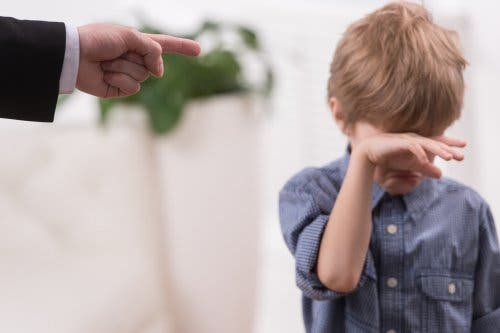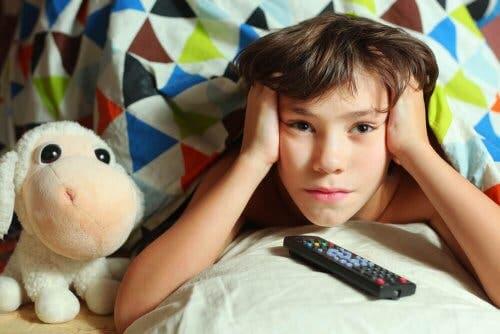How to Approach ADHD Effectively


Reviewed and approved by biologist and doctor María Belén del Río
Having a child with Attention Deficit Hyperactivity Disorder (ADHA) can be a daily challenge that includes frustrating and very stressful moments.
However, while it may seem difficult, some simple strategies can help make giving your child the best education easier. Therefore, parents need to know how to approach ADHD effectively.
Normal household routines might not work if your child has ADHD. Plus, traditional education methods aren’t always effective. Therefore, parents and educators must comprehend that children with this condition have different needs and reactions.
We can’t expect our children to change. Rather, we must adjust and adapt in order to help our children with ADHD thrive.
Characteristics of children with ADHD
To approach ADHD effectively, we need to understand the characteristics of children with this condition. First, not all children with Attention Deficit Hyperactivity Disorder behave in the same way.
The symptoms that appear can vary in their intensity and can even present themselves independently. In fact, most children with ADHD only present one of two groups of symptoms.
The three main characteristics of ADHD are hyperactivity, attention deficit, and impulsiveness. Also, each one has its own particular sub-symptoms.

Hyperactivity
- Restlessness: Children with ADHD may have a difficult time staying still.
- Constant talking, even when they shouldn’t.
- They make noises when they aren’t talking.
- Difficulty relaxing.
- Move onto a new activity before finishing the previous one.
- Quickly becoming bored.
Attention-deficit
- Having a hard time concentrating.
- Having difficulty paying attention for a long period.
- Easily distracted by stimuli in their environment.
- Not paying attention to details.
- A tendency to not follow orders or instructions.
- They are untidy and have a hard time organizing tasks.
- Often forgetting where they left things.
- They may change the subject in ways that don’t seem to make sense.
Impulsiveness
- Impatience.
- Children act impulsively, without thinking about what they’re about to do.
- A tendency to interrupt the activities and conversations of others.
- Often grabbing any item that’s within their reach.
- Responding in aggressive or dominant ways.
- Refusal to allow others to control them or dominate them.
What’s more, 70 % of those that suffer from ADHD have other coexisting conditions. For example, anxiety, depression, post-traumatic stress disorder, etc, are all common.
How to approach ADHD effectively: The dos and Don’ts
Some adjustments in the way parents relate to their children can have a very positive effect on behavior. It can also help them better manage situations that arise. At the same time, some techniques that work in traditional education may produce negative effects in children with ADHD.
DON’t use punishments

In most cases, when children with ADHD disobey instructions or do something they shouldn’t, it’s because of distraction. In other words, it’s not an act of rebellion or intentional disobedience.
Dr. Rusell Barkley, a psychologist that specializes in ADHD, affirms that punishment is only a short-term solution. In the long run, children lose the motivation to do the things people ask of them.
Just the same, they feel anger and frustration. They quickly forget the lesson and learn to be aggressive instead.
DO use entertainment and specific motivation for children with ADHD
A study conducted by Ohio University found that entertainment and rewards produce positive rewards. If you want your children with ADHD to do something specific, do it with them the first few times. Then, congratulate them when they do it on their own.
Discover more: Signs of Attention Deficit Disorder in Children
DON’T Improvise rules
Children with ADHD may have a hard time understanding and remembering household rules and rules about behavior. Learning them and internalizing them can take time, and is even harder if they change.
Of course, you’ll make mistakes along the way, but avoid changing and adding new rules constantly.
DO establish clear rules and allow for flexibility
Rules must be clear, simple, and easy to follow. You can write them on a piece of paper and place them in a visible spot. Then remember, the learning process won’t happen overnight.
Therefore, you’ll need to flexible and patient when it comes to accepting errors. Also, remember to reward achievements in some way and to avoid punishments.
DON’T individualize problems
When you have a problem–your children with ADHD don’t obey or haven’t followed instruction–resist the temptation to blame them. Avoid calling them absent-minded or lazy.
Also, don’t reprimand them for what they did or didn’t do with phrases like “Why didn’t you do this?” or “Why did you do this?” More likely than not, your child won’t have a reason to give and will feel even more frustrated.
DO work as a team as you approach ADHD

Don’t try to place blame. Rather, look for solutions together and invite your child to be part of the solution.
Use phrases like “We have a problem. How can we fix it?”. Allow children to suggest what actions to take and if they’re right, reward them verbally. If they don’t offer the best answer, don’t discourage them. Rather, guide them toward an adequate solution.
“But when you team up with your child to problem-solve various negative behaviors, you create a climate where your child feels loved and supported despite her shortcomings,” explains Carol Brady, a child psychologist.
DON’t say no without thinking
Sometimes you need to say no, but it’s best to think a bit before just saying no straight out. Sometimes, the “no” is a product of our own worries and our desire for control, rather than a true need. Therefore, it’s best to ask yourself if there’s another possible answer.
Another thing to consider is that children with ADHD are prone to rebellion. This is understandable, since an excess of negative responses and stimulate this kind of behavior.
DO say yes to say no
If you’re sure the answer needs to be “no,” find a creative way to respond by using a “yes.”
Make a proposal and allow for negotiation, motivating your child by allowing him or her to participate in this new proposal. That doesn’t mean you can never give a negative answer, but you should look for a kind way to do it.
DON’T be flexible with bedtime
Children with ADHD tend to have a hard time falling asleep. And when they don’t get enough sleep, their hyperactivity and distractibility increase.
It’s logical to think that you need to let them sleep whenever they’re tired. But if you do, they won’t get enough sleep and, therefore, won’t get the rest their minds and bodies needs. When they’re tired before it’s time to go to bed, find other activities to capture their attention.
You may also want to read: Appropriate Sleeping Hours by Age
DO create a sleep routine
Establishing a sleep routine is fundamental. Whether it’s nap time or bedtime, set a specific time for going to sleep. Turn off the lights, keep the house as peaceful as possible, and help your child fall asleep.
Avoid sweets, caffeinated drinks, and any other stimulant and turn off the TV. In short, create a ritual before your child goes to bed.
Other considerations regarding how to approach ADHD
Talk to your doctor about medication

If our child’s doctor recommends any type of medication, you need to be strict about its administration. Medications are very helpful when it comes to controlling symptoms. If you have any doubts or concerns, be sure to discuss them with the doctor.
Create a specific exercise routine as a way to approach ADHD
Physical activities can help children with ADHD burn off excess energy. What’s more, it helps them to focus and reduces their impulsivity.
Divide tasks into parts
Things that may seem simple for anyone else may seem like a big struggle for children with ADHD. Therefore, it’s best to divide tasks into smaller activities that are easier for children to manage.
Help them with a written agenda of these activities and separate them by color. That way, they’ll be easier to distinguish so that kids can check them off as individual tasks. Don’t just make a list, which your child will consider impossible to tackle.
Limit distractions

Anything in the environment of children with ADHD can capture their attention. As much as possible, create special spaces for their activities.
Don’t put a TV or videogames in the room where they sleep or do their homework. Also, put toys away when it’s time to go to bed and turn off the TV when you eat.
Take breaks
Both children with ADHD and their parents need to take breaks. Children need to pause in the middle of their activities to keep from feeling overwhelmed. Nor is it good for children to constantly depend on their parents.
They need to learn to trust in themselves. Meanwhile, you need some free time to relax and not feel weighed down.
Turn to a professional to help you successfully approach ADHD
Even if you think you can handle this on your own, you need to recognize that you may need assistance. A psychologist that specialized in ADHD will provide tools that will open a world of opportunities for your child.
You can also look for help in your home with specialized childcare providers. This will allow you to rest and spend time on other activities and responsibilities, knowing your child is in good hands.
All cited sources were thoroughly reviewed by our team to ensure their quality, reliability, currency, and validity. The bibliography of this article was considered reliable and of academic or scientific accuracy.
- Quintanar Rojas, L., Gómez Moya, R., Solovieva, Y., & Bonilla Sánchez, M. D. R. (2011). Características neuropsicológicas de niños preescolares con trastorno por déficit de atención con hiperactividad. Revista CES psicología, 4(1), 16-31. https://www.redalyc.org/pdf/4235/423539418003.pdf
- Servera-Barceló, M. (2005). Modelo de autorregulación de Barkley aplicado al trastorno por déficit de atención con hiperactividad: una revisión. Revista de neurología, 40(6), 358-368. https://www.researchgate.net/publication/7939840_Barkley%27s_model_of_self-regulation_applied_to_attention_deficit_hyperactivity_disorder_A_review
- KidsHealth. (n.d.). La crianza de un niño con TDAH. KidsHealth. https://kidshealth.org/es/parents/parenting-kid-adhd.html?WT.ac=pairedLink
- Fernández-Jaén, A., & Fernández-Mayoralas, D. M. (2010). Medicamentos estimulantes en el tratamiento del trastorno por déficit de atención/hiperactividad. Terapéutica Journal, 69-72. http://afantdah.org/images/stories/Documentacion/janomedicamentosestimulanteseneltratamientodeltdah.pdf
- Rivera, A. L., & Remón, Á. L. C. (2017). Beneficios de la actividad físico-deportiva en niños y niñas con TDAH. EmásF: revista digital de educación física, (44), 63-78. https://dialnet.unirioja.es/servlet/articulo?codigo=5807535
This text is provided for informational purposes only and does not replace consultation with a professional. If in doubt, consult your specialist.








